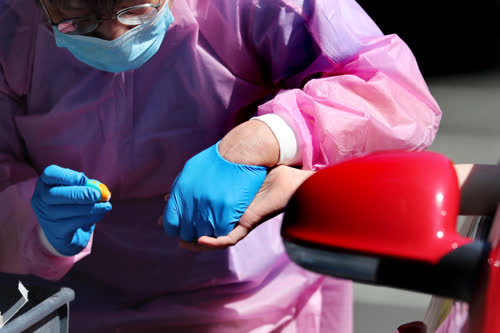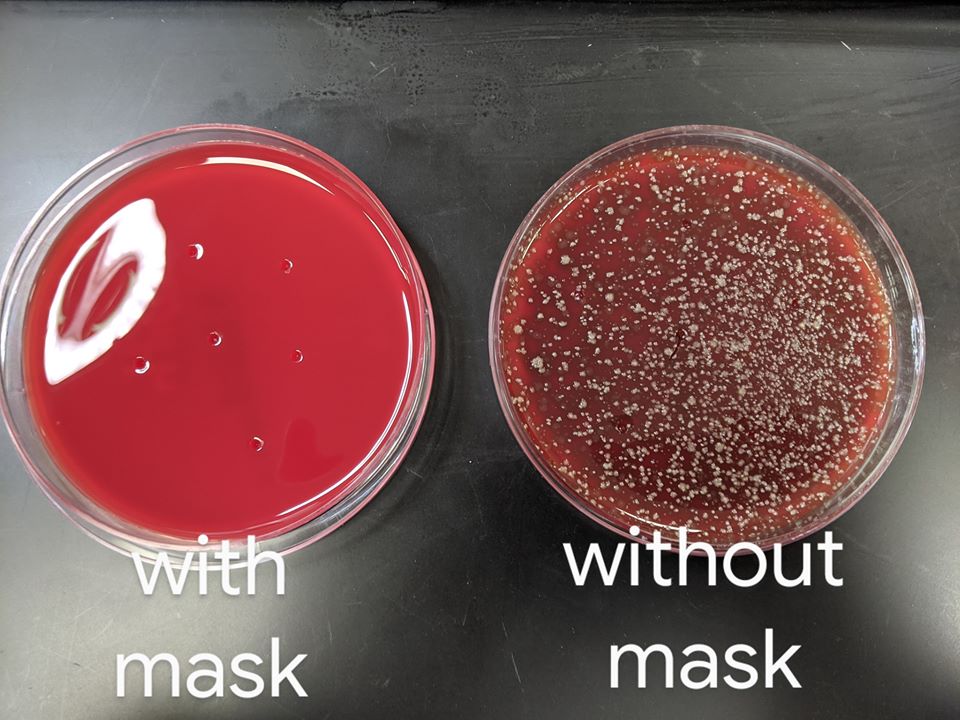|
Investigating the impact of influenza on excess mortality in all ages in Italy during recent seasons (2013/14–2016/17 seasons) Abstract |
|
COVID-19 outbreak at a large homeless shelter in Boston: Implications for universal testing The circumstances of homelessness create the potential for rapid transmission of SARS-CoV-2 in this vulnerable population. Upon observing a cluster of COVID-19 cases from a single large homeless shelter in Boston, Boston Health Care for the Homeless Program conducted symptom assessments and polymerase chain reaction (PCR) testing for SARS-CoV-2 among all guests residing at the shelter over a 2-day period. Of 408 participants, 147 (36.0%) were PCR-positive for SARS-CoV-2. COVID-positive individuals were more likely to be male (p<0.001) but did not differ significantly from COVID-negative individuals with respect to other demographic and clinical characteristics. Cough (7.5%), shortness of breath (1.4%), and fever (0.7%) were all uncommon among COVID-positive individuals. Our findings illustrate the rapidity with which COVID-19 can be widely transmitted in a homeless shelter setting and suggest that universal PCR testing, rather than a symptom triggered approach, may be a better strategy for identifying and mitigating COVID-19 among people experiencing homelessness. |
|
COVID-19 Antibody Seroprevalence in Santa Clara County, California Background Addressing COVID-19 is a pressing health and social concern. To date, many epidemic projections and policies addressing COVID-19 have been designed without seroprevalence data to inform epidemic parameters. We measured the seroprevalence of antibodies to SARS-CoV-2 in Santa Clara County. Methods On 4/3-4/4, 2020, we tested county residents for antibodies to SARS-CoV-2 using a lateral flow immunoassay. Participants were recruited using Facebook ads targeting a representative sample of the county by demographic and geographic characteristics. We report the prevalence of antibodies to SARS-CoV-2 in a sample of 3,330 people, adjusting for zip code, sex, and race/ethnicity. We also adjust for test performance characteristics using 3 different estimates: (i) the test manufacturer's data, (ii) a sample of 37 positive and 30 negative controls tested at Stanford, and (iii) a combination of both. Results The unadjusted prevalence of antibodies to SARS-CoV-2 in Santa Clara County was 1.5% (exact binomial 95CI 1.11-1.97%), and the population-weighted prevalence was 2.81% (95CI 2.24-3.37%). Under the three scenarios for test performance characteristics, the population prevalence of COVID-19 in Santa Clara ranged from 2.49% (95CI 1.80-3.17%) to 4.16% (2.58-5.70%). These prevalence estimates represent a range between 48,000 and 81,000 people infected in Santa Clara County by early April, 50-85-fold more than the number of confirmed cases. Conclusions The population prevalence of SARS-CoV-2 antibodies in Santa Clara County implies that the infection is much more widespread than indicated by the number of confirmed cases. Population prevalence estimates can now be used to calibrate epidemic and mortality projections. |
|
SARS-CoV-2–Positive Sputum and Feces After Conversion of Pharyngeal Samples in Patients With COVID-19 Pharyngeal swabs are widely used to determine the appropriateness of a patient's discharge from the hospital and whether isolation continues to be required. We observed 22 patients who had positive RT-qPCR results for SARS-CoV-2 in the sputum or feces after pharyngeal swabs became negative. These findings raise concern about whether patients with negative pharyngeal swabs are truly virus-free, or sampling of additional body sites is needed. It is important to emphasize, however, that it is not known whether the positive RT-qPCR results for SARS-CoV-2 observed here indicate that a patient continues to pose a risk for infection to others. Related, positive throat samples (after negative samples) after hospital discharge have been reported (5).
|
|
Aerosol and Surface Distribution of Severe Acute Respiratory Syndrome Coronavirus 2 in Hospital Wards, Wuhan, China, 2020 To determine distribution of severe acute respiratory syndrome coronavirus 2 in hospital wards in Wuhan, China, we tested air and surface samples. Contamination was greater in intensive care units than general wards. Virus was widely distributed on floors, computer mice, trash cans, and sickbed handrails and was detected in air ≈4 m from patients. |
|
Spread of SARS-CoV-2 in the Icelandic Population As of April 4, a total of 1221 of 9199 persons (13.3%) who were recruited for targeted testing had positive results for infection with SARS-CoV-2. Of those tested in the general population, 87 (0.8%) in the open-invitation screening and 13 (0.6%) in the random-population screening tested positive for the virus. In total, 6% of the population was screened. Most persons in the targeted-testing group who received positive tests early in the study had recently traveled internationally, in contrast to those who tested positive later in the study. Children under 10 years of age were less likely to receive a positive result than were persons 10 years of age or older, with percentages of 6.7% and 13.7%, respectively, for targeted testing; in the population screening, no child under 10 years of age had a positive result, as compared with 0.8% of those 10 years of age or older. Fewer females than males received positive results both in targeted testing (11.0% vs. 16.7%) and in population screening (0.6% vs. 0.9%). The haplotypes of the sequenced SARS-CoV-2 viruses were diverse and changed over time. The percentage of infected participants that was determined through population screening remained stable for the 20-day duration of screening. |
|
Possibly critical role of wearing masks in general population in controlling COVID‐19 Coronavirus disease 2019 (COVID‐19), caused by severe acute respiratory syndrome coronavirus 2 (SARS‐CoV‐2), is now overwhelming spreading in the world. As of April 11, 2020, totally 1.61 million COVID‐19 patients were confirmed in more than 200 countries and regions with 99690 deaths. |
|
Reconstruction of the full transmission dynamics of COVID-19 in Wuhan As countries in the world review interventions for containing the pandemic of coronavirus disease 2019 (COVID-19), important lessons can be drawn from the study of the full transmission dynamics of its causative agent—severe acute respiratory syndrome coronavirus 2 (SARS-CoV-2)— in Wuhan (China), where vigorous non-pharmaceutical interventions have suppressed the local outbreak of this disease1. Here we use a modelling approach to reconstruct the full-spectrum dynamics of COVID-19 in Wuhan between 1 January and 8 March 2020 across 5 periods defined by events and interventions, on the basis of 32,583 laboratory-confirmed cases1. Accounting for presymptomatic infectiousness2, time-varying ascertainment rates, transmission rates and population movements3, we identify two key features of the outbreak: high covertness and high transmissibility. We estimate 87% (lower bound, 53%) of the infections before 8 March 2020 were unascertained (potentially including asymptomatic and mildly symptomatic individuals); and a basic reproduction number (R0) of 3.54 (95% credible interval 3.40–3.67) in the early outbreak, much higher than that of severe acute respiratory syndrome (SARS) and Middle East respiratory syndrome (MERS)4,5. We observe that multipronged interventions had considerable positive effects on controlling the outbreak, decreasing the reproduction number to 0.28 (95% credible interval 0.23–0.33) and—by projection—reducing the total infections in Wuhan by 96.0% as of 8 March 2020. We also explore the probability of resurgence following the lifting of all interventions after 14 consecutive days of no ascertained infections; we estimate this probability at 0.32 and 0.06 on the basis of models with 87% and 53% unascertained cases, respectively—highlighting the risk posed by substantial covert infections under changing control measures. These results have important implications when considering strategies of continuing surveillance and interventions to eventually contain outbreaks of COVID-19. |
|
FAQs on Protecting Yourself from COVID-19 Aerosol Transmission The goal of these FAQs is to provide information to the general public in an efficient manner about how to prevent aerosol transmission of COVID-19, with the hope that this will allow more informed decision making by individuals or organizations. All of this information has been posted in Twitter and other forums, but can be difficult to find. Having multiple experts working together, and having the ability to update this information also improves its quality. These FAQs represent our best understanding at this time, and should always be similar or more stringent than information provided by CDC, WHO, and most regional & local health authorities. If your authority has a more stringent guideline than discussed here, follow that more stringent guideline.
|
|
Aerodynamic Characteristics and RNA Concentration of SARS-CoV-2 Aerosol in Wuhan Hospitals during COVID-19 Outbreak Results: The ICU, CCU and general patient rooms inside Renmin, patient hall inside Fangcang had undetectable or low airborne SARS-CoV-2 concentration but deposition samples inside ICU and air sample in Fangcang patient toilet tested positive. The airborne SARS-CoV-2 in Fangcang MSA had bimodal distribution with higher concentration than those in Renmin during the outbreak but turned negative after patients number reduced and rigorous sanitization implemented. PUA had undetectable airborne SARS-CoV-2 concentration but obviously increased with accumulating crowd flow.
|
|
COVID-19 Outbreak Associated with Air Conditioning in Restaurant, Guangzhou, China, 2020 During January 26–February 10, 2020, an outbreak of 2019 novel coronavirus disease in an air-conditioned restaurant in Guangzhou, China, involved 3 family clusters. The airflow direction was consistent with droplet transmission. To prevent the spread of the virus in restaurants, we recommend increasing the distance between tables and improving ventilation. |
|
Estimating the asymptomatic proportion of coronavirus disease 2019 (COVID-19) cases on board the Diamond Princess cruise ship, Yokohama, Japan, 2020 An outbreak of coronavirus disease 2019 (COVID-19) unfolded on board a Princess Cruises’ ship called the Diamond Princess. Shortly after arriving in Yokohama, Japan, this ship had been placed under quarantine orders from 5 February 2020, after a former passenger had tested positive for the virus responsible for the disease (i.e. severe acute respiratory syndrome coronavirus 2; SARS-CoV-2), subsequent to disembarking in Hong Kong. In this study, we conducted a statistical modelling analysis to estimate the proportion of asymptomatic individuals among those who tested positive for SARS-CoV-2 on board the ship until 20 February 2020 included, along with their times of infections. The model accounted for the delay in symptom onset and also for right censoring, which can occur due to the time lag between a patient’s examination and sample collection and the development of illness. |
|
Aerosol and Surface Stability of SARS-CoV-2 as Compared with SARS-CoV-1 SARS-CoV-2 was more stable on plastic and stainless steel than on copper and cardboard, and viable virus was detected up to 72 hours after application to these surfaces (Figure 1A), although the virus titer was greatly reduced (from 103.7 to 100.6 TCID50 per milliliter of medium after 72 hours on plastic and from 103.7 to 100.6 TCID50 per milliliter after 48 hours on stainless steel). The stability kinetics of SARS-CoV-1 were similar (from 103.4 to 100.7 TCID50 per milliliter after 72 hours on plastic and from 103.6 to 100.6 TCID50 per milliliter after 48 hours on stainless steel). On copper, no viable SARS-CoV-2 was measured after 4 hours and no viable SARS-CoV-1 was measured after 8 hours. On cardboard, no viable SARS-CoV-2 was measured after 24 hours and no viable SARS-CoV-1 was measured after 8 hours (Figure 1A). |
|
Indoor transmission of SARS-CoV-2 Background: By early April 2020, the COVID-19 pandemic had infected nearly one million people and had spread to nearly all countries worldwide. It is essential to understand where and how SARS-CoV-2 is transmitted. Methods: Case reports were extracted from the local Municipal Health Commissions of 320 prefectural cities (municipalities) in China, not including Hubei province, between 4 January and 11 February 2020. We identified all outbreaks involving three or more cases and reviewed the major characteristics of the enclosed spaces in which the outbreaks were reported and associated indoor environmental issues. Results: Three hundred and eighteen outbreaks with three or more cases were identified, involving 1245 confirmed cases in 120 prefectural cities. We divided the venues in which the outbreaks occurred into six categories: homes, transport, food, entertainment, shopping, and miscellaneous. Among the identified outbreaks, 53.8% involved three cases, 26.4% involved four cases, and only 1.6% involved ten or more cases. Home outbreaks were the dominant category (254 of 318 outbreaks; 79.9%), followed by transport (108; 34.0%; note that many outbreaks involved more than one venue category). Most home outbreaks involved three to five cases. We identified only a single outbreak in an outdoor environment, which involved two cases. Conclusions: All identified outbreaks of three or more cases occurred in an indoor environment, which confirms that sharing indoor space is a major SARS-CoV-2 infection risk. |
|
"viable virus was isolated for up to 28 days at 20 °C from common surfaces such as glass, stainless steel and both paper and polymer banknotes." The effect of temperature on persistence of SARS-CoV-2 on common surfaces |
|
R0 = 5.7 ; High Contagiousness and Rapid Spread of Severe Acute Respiratory Syndrome Coronavirus 2 Severe acute respiratory syndrome coronavirus 2 is the causative agent of the 2019 novel coronavirus disease pandemic. Initial estimates of the early dynamics of the outbreak in Wuhan, China, suggested a doubling time of the number of infected persons of 6–7 days and a basic reproductive number (R0) of 2.2–2.7. We collected extensive individual case reports across China and estimated key epidemiologic parameters, including the incubation period. We then designed 2 mathematical modeling approaches to infer the outbreak dynamics in Wuhan by using high-resolution domestic travel and infection data. Results show that the doubling time early in the epidemic in Wuhan was 2.3–3.3 days. Assuming a serial interval of 6–9 days, we calculated a median R0 value of 5.7 (95% CI 3.8–8.9). We further show that active surveillance, contact tracing, quarantine, and early strong social distancing efforts are needed to stop transmission of the virus. |
|
Susceptibility of ferrets, cats, dogs, and other domesticated animals to SARS–coronavirus 2 The authors found that SARS-CoV-2 infects the upper respiratory tracts of ferrets but is poorly transmissible between individuals. In cats, the virus replicated in the nose and throat and caused inflammatory pathology deeper in the respiratory tract, and airborne transmission did occur between pairs of cats. Dogs appeared not to support viral replication well and had low susceptibility to the virus, and pigs, chickens, and ducks were not susceptible to SARS-CoV-2. |
|
A new coronavirus associated with human respiratory disease in China.: "...the first patient was hospitalized on 12 December 2019" Emerging infectious diseases, such as severe acute respiratory syndrome (SARS) and Zika virus disease, present a major threat to public health1-3. Despite intense research efforts, how, when and where new diseases appear are still a source of considerable uncertainty. A severe respiratory disease was recently reported in Wuhan, Hubei province, China. As of 25 January 2020, at least 1,975 cases had been reported since the first patient was hospitalized on 12 December 2019. Epidemiological investigations have suggested that the outbreak was associated with a seafood market in Wuhan. Here we study a single patient who was a worker at the market and who was admitted to the Central Hospital of Wuhan on 26 December 2019 while experiencing a severe respiratory syndrome that included fever, dizziness and a cough. Metagenomic RNA sequencing4 of a sample of bronchoalveolar lavage fluid from the patient identified a new RNA virus strain from the family Coronaviridae, which is designated here 'WH-Human 1' coronavirus (and has also been referred to as '2019-nCoV'). Phylogenetic analysis of the complete viral genome (29,903 nucleotides) revealed that the virus was most closely related (89.1% nucleotide similarity) to a group of SARS-like coronaviruses (genus Betacoronavirus, subgenus Sarbecovirus) that had previously been found in bats in China5. This outbreak highlights the ongoing ability of viral spill-over from animals to cause severe disease in humans. |
|
Transmission routes of Covid-19 virus in the Diamond Princess Cruise ship Background: An outbreak of COVID-19 occurred on the Diamond Princess cruise ship in January and February 2020. We analysed information about cases to infer transmission dynamics and potential modes of transmission. Methods: We collected the daily number of 197 symptomatic cases, and that of the 146 passenger cases in two categories, i.e. those who stayed and did not stay in the same stateroom. We retrieved the quarantine details and the ship's 14-day itinerary. We searched the websites of national/local health authority along the cruise routes and local news using Google for locally confirmed cases associated with the ship. We obtained the design of air conditioning and sewage treatment of the ship from literature. We back-calculated the dates of infection from the epidemic curve and compared with the start of on-board quarantine. Results: Major infections started on Jan 28 and completed by Feb 6 for passengers except those who stayed in the same stateroom with infected individual(s). No other confirmed cases were identified among the disembarked people in Hong Kong except an 80 years old passenger. No confirmed cases were reported in three other stopovers between Jan 27-31 associated with disembarked passengers or visitors from the ship, however two Okinawa taxi drivers became confirmed cases in association with driving the ship passengers. Infection among passengers after Feb 6 was limited to those who stayed in the same stateroom with an infected passenger. Infections in crew members peaked on Feb 7, suggesting significant transmission among crew members after quarantine on Feb 5. Conclusions: We infer that the ship central air conditioning system did not play a role, i.e. the long-range airborne route was absent in the outbreak. Most transmission appears to have occurred through close contact and fomites. |
|
Identifying airborne transmission as the dominant route for the spread of COVID-19 We have elucidated the transmission pathways of coronavirus disease 2019 (COVID-19) by analyzing the trend and mitigation measures in the three epicenters. Our results show that the airborne transmission route is highly virulent and dominant for the spread of COVID-19. The mitigation measures are discernable from the trends of the pandemic. Our analysis reveals that the difference with and without mandated face covering represents the determinant in shaping the trends of the pandemic. This protective measure significantly reduces the number of infections. Other mitigation measures, such as social distancing implemented in the United States, are insufficient by themselves in protecting the public. Our work also highlights the necessity that sound science is essential in decision-making for the current and future public health pandemics. |
|
"The longest observed duration of viral shedding in survivors was 37 days" Clinical course and risk factors for mortality of adult inpatients with COVID-19 in Wuhan, China: a retrospective cohort study
|
|
Face masks effectively limit the probability of SARS-CoV-2 transmission Airborne transmission by droplets and aerosols is important for the spread of viruses. Face masks are a well-established preventive measure, but their effectiveness for mitigating SARS-CoV-2 transmission is still under debate. We show that variations in mask efficacy can be explained by different regimes of virus abundance and related to population-average infection probability and reproduction number. For SARS-CoV-2, the viral load of infectious individuals can vary by orders of magnitude. We find that most environments and contacts are under conditions of low virus abundance (virus-limited) where surgical masks are effective at preventing virus spread. More advanced masks and other protective equipment are required in potentially virus-rich indoor environments including medical centers and hospitals. Masks are particularly effective in combination with other preventive measures like ventilation and distancing. |
|
COVID-19 Pandemic Triggers a Dramatic Decline in Diagnoses of Cardiovascular Risk Factors, Chronic Diseases and Some Cancers New diagnoses of cardiovascular risk factors, common chronic conditions and some cancers have dramatically declined during the COVID-19 pandemic, according to a study recently published online in Annals of Family Medicine.
|
|
This scientist made a Google Doc to educate the public about airborne coronavirus transmission The evidence that the coronavirus spreads through the air has been mounting for months—but official guidance has barely shifted. Jose-Luis Jimenez has had enough. |
|
342 Coronavirus: Santa Clara County has had 50 to 85 times more cases than we knew about, Stanford estimates In a startling finding, new Stanford research reveals between 48,000 and 81,000 people in Santa Clara County alone may already have been infected by the coronavirus by early April — that’s 50 to 85 times more than the number of official cases at that date.
|
|
Why are bat viruses so deadly? A study of cultured bat cells shows that their strong immune responses, constantly primed to respond to viruses, can drive viruses to greater virulence. Modelling bat immune systems on a computer, the researchers showed that when bat cells quickly release interferon upon infection, other cells quickly wall themselves off. This drives viruses to faster reproduction. The increased virulence and infectivity wreak havoc when these viruses infect animals with tamer immune systems, like humans. |
|
Estimates of the spread of the disease
|
|
Katie Corley - Why masks work.
|
|
Coronavirus: WHO rethinking how Covid-19 spreads in air For months, the WHO has insisted that Covid-19 is transmitted via droplets emitted when people cough or sneeze. Droplets that do not linger in the air, but fall onto surfaces - that's why handwashing has been identified as a key prevention measure.
|





